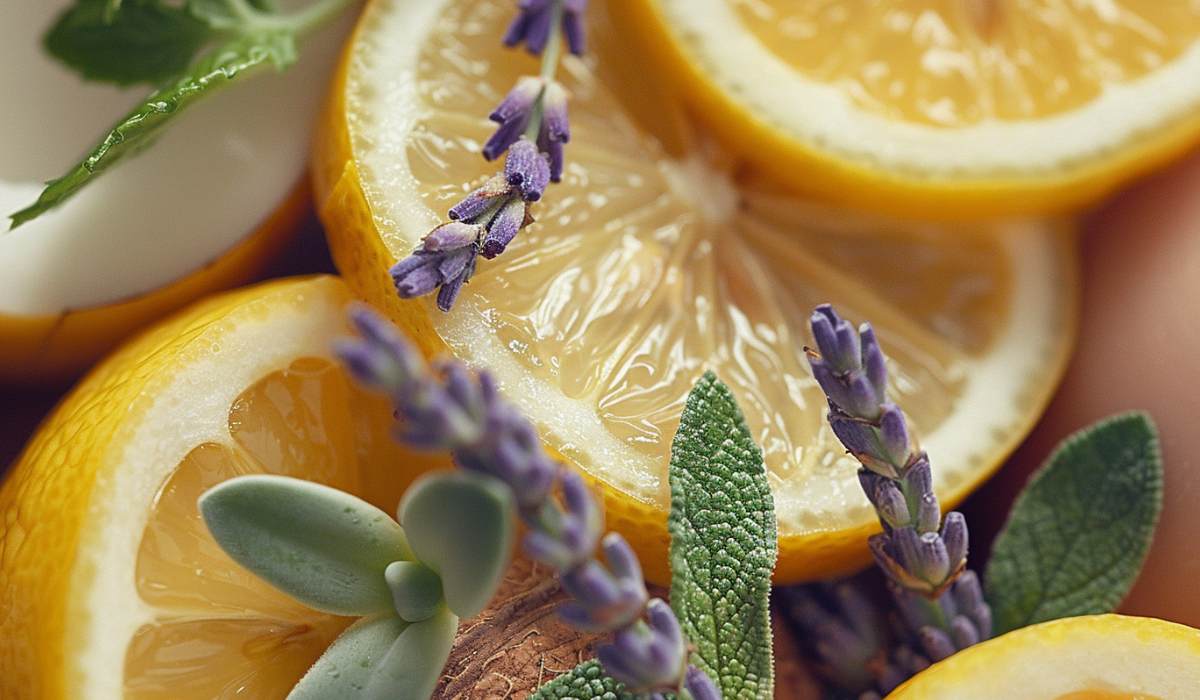Here’s Your Ultimate Guide to Natural “Scar Faders”
Scars tell stories, but sometimes we’d rather edit the narrative.
Nature’s laboratory can rewrite skin’s history, if that is your wish.
From desert-dwelling aloe to tropical coconuts, each ingredient I bring you here is a character in your skin’s renewal saga.
These aren’t your grandmother’s remedies – they’re backed by science, embraced by modern skincare.
Ready to turn the page on conventional treatments?
Let’s explore this botanical bestseller list.
Disclaimer: I link to affiliate products below. If you purchase through my links I might earn a commission at no extra cost to you.
🌿 Aloe vera – best for fresh scars, burns, and inflammation
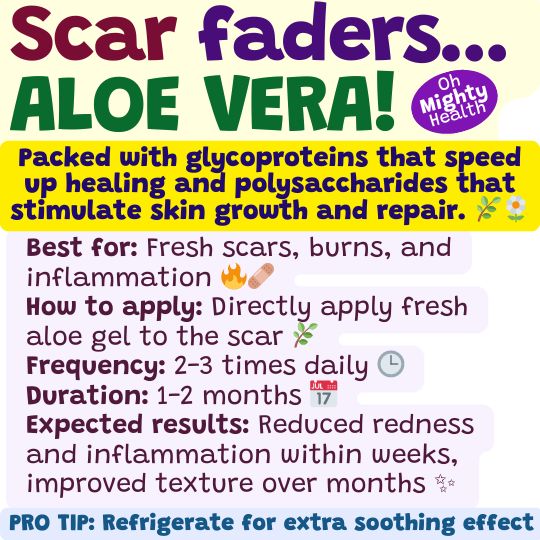
Aloe vera, often called the “burn plant,” is a succulent superstar in scar treatment. Aloe is packed with glycoproteins that speed up healing and polysaccharides that stimulate skin growth (and repair).
Aloe vera’s gel is a cocktail of vitamins (A, C, E), enzymes, and amino acids that work together to reduce inflammation and boost collagen production. The plant’s natural antiseptic components, like salicylic acid, help prevent infection in fresh wounds. The high water content keeps the skin hydrated – such an important factor in minimising the formation of scars! SCIENCE BASED.
Aloe’s ability to penetrate deep into the skin (it penetrates ALL the layers) makes it a fast-acting, very effective remedy for different types of scars – from burns to surgical incisions, yes.
- Best for: Fresh scars, burns, and inflammation
- How to apply: Directly apply fresh aloe gel to the scar
- Frequency: 2-3 times daily
- Duration: 1-2 months
- Expected results: Reduced redness and inflammation within weeks, improved texture over months
💡📌 PRO TIP: Refrigerate for extra soothing effect
MY RECOMMENDED ALOE VERA GEL HERE.
🌹 Rosehip oil – best for old scars and hyperpigmentation
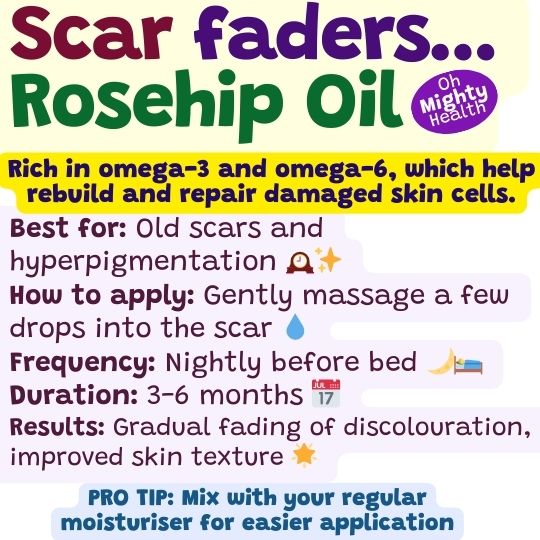
Rosehip oil (extracted from the seeds of wild rose bushes), is fantastic for scar treatment as well as skin regeneration. This golden liquid is RICH in essential fatty acids (particularly omega-3 and omega-6).
These fatty acids in rosehip oil help rebuild and repair damaged skin cells. Its high concentration of trans-retinoic acid, a natural form of vitamin A, promotes skin cell turnover and collagen production. Yes, they’re crucial for reducing the appearance of scars and hyperpigmentation! Rosehip oil is a potent antioxidant, vitamins C and E, which protect the skin from further damage. SCIENCE BASED.
Rosehip oil deeply penetrates the skin’s layers makes it EXCEPTIONALLY effective at improving skin texture, tone, and elasticity. So, yes, it is go-to remedy for old scars also.
- Best for: Old scars (also new scars) and hyperpigmentation
- How to apply: Gently massage a few drops into the scar
- Frequency: Nightly before bed
- Duration: 3-6 months
- Expected results: Gradual fading of discolouration, improved skin texture
💡📌 PRO TIP: Mix with your regular moisturiser for easier application
MY RECOMMENDED ROSEHIP OIL HERE.
🥑 Vitamin E oil – best for surgical scars and stretch marks
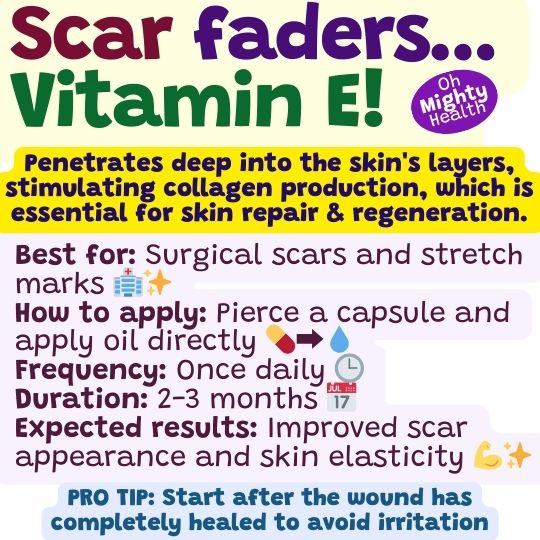
Vitamin E oil is renowned for its healing and protective properties. This “fat-soluble” antioxidant works at a cellular level to neutralise free radicals! (they impair the skin’s healing process…)
Vitamin E oil’s helps keep the skin elastic, reducing scars and stretch marks. It boosts blood flow, bringing nutrients to healing areas. By penetrating deep into the skin, it stimulates collagen production for better skin repair. It also protects the skin from UV damage, preventing scars from getting darker. SCIENCE BASED.
This makes vitamin E oil especially effective for surgical scars and stretch marks, where skin elasticity and healing are important!
- Best for: Surgical scars and stretch marks
- How to apply: Pierce a capsule and apply oil directly
- Frequency: Once daily
- Duration: 2-3 months
- Expected results: Improved scar appearance and skin elasticity
💡📌 PRO TIP: Start after the wound has completely healed to avoid irritation
MY RECOMMENDED VITAMIN E OIL HERE.
🥥 Coconut oil – best for acne scars and dry, rough scars
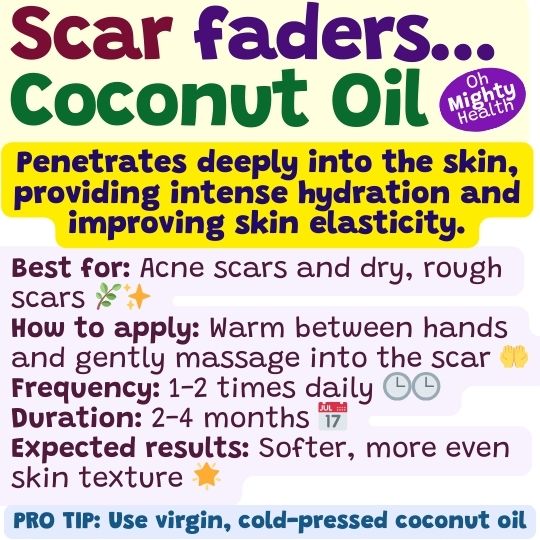
Coconut oil, made from mature coconuts, is a versatile remedy for scars and skin health. It’s rich in lauric acid, which has strong antimicrobial properties to keep the skin clean and infection-free.
Coconut oil is rich in vitamin E and antioxidants, which help fight free radical damage and support skin healing. Its deep-penetrating, moisturising properties improve skin elasticity, reducing scars from acne or dry skin. It also contains proteins that help with cell health and tissue repair. SCIENCE BASED.
The oil boosts collagen production, reducing scar formation. Its anti-inflammatory properties soothe irritated skin, making it especially good for acne-prone skin and reducing post-acne scars.
- Best for: Acne scars and dry, rough scars
- How to apply: Warm between hands and gently massage into the scar
- Frequency: 1-2 times daily
- Duration: 2-4 months
- Expected results: Softer, more even skin texture
💡📌 PRO TIP: Use virgin, cold-pressed coconut oil for best results
MY RECOMMENDED COCONUT OIL HERE.
🧈 Shea butter – best for keloid scars and improving skin elasticity
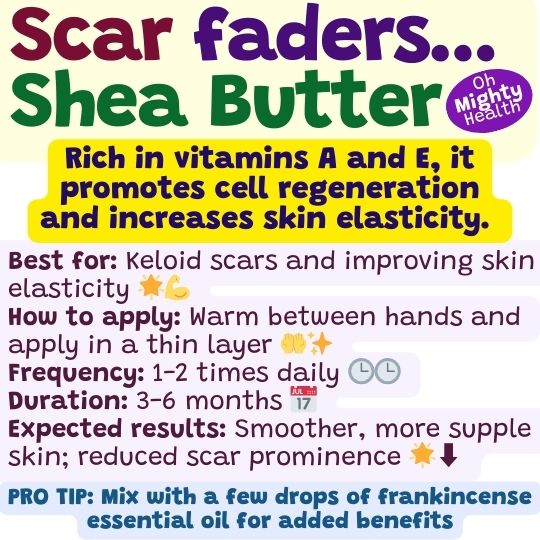
Shea butter, extracted from the nuts of the African shea tree, is wonderful for scar treatment. Rich in vitamins A and E, it promotes cell regeneration and increases skin elasticity.
Shea butter’s high concentration of fatty acids provides deep moisturisation and creates a protective barrier on the skin. Shea butter’s content of triterpenes offers remarkable anti-inflammatory and antioxidant properties, soothing irritated skin and combating free radical damage. It also contains cinnamic acid (what gives shea butter its SPF), providing mild sun protection for healing skin. PHOTOS HERE.
Shea butter stimulates collagen production, improving the texture of keloid scars. Its emollient properties soften and smooth rough scar tissue over time.
- Best for: Keloid scars and improving skin elasticity
- How to apply: Warm between hands and apply in a thin layer
- Frequency: 1-2 times daily
- Duration: 3-6 months
- Expected results: Smoother, more supple skin; reduced scar prominence
💡📌 PRO TIP: Mix with a few drops of frankincense essential oil for added benefits
MY RECOMMENDED SHEA BUTTER HERE.
🍫 Cocoa butter – best for PREVENTING scars and HELP FADE existing ones (it doesn’t remove scars)
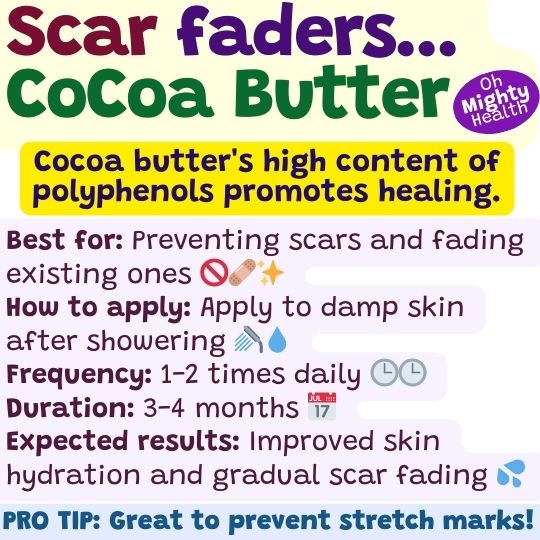
Cocoa butter, derived from cocoa beans, is a luxurious natural fat known for its skin-healing properties. Rich in fatty acids like oleic, stearic, and palmitic acids, it provides deep, long-lasting HYDRATION to the skin.
Cocoa butter’s intense moisturisation is key to maintaining skin elasticity and preventing new scars. Cocoa butter’s high content of polyphenols gives it potent antioxidant properties, protecting the skin from free radical damage and promoting healing. It forms a protective barrier on the skin, locking in moisture.
DOES IT REMOVE SCARS? Cocoa butter doesn’t completely remove scars. Instead, it helps with healing by keeping the skin hydrated and promoting a more even tone. Its rich fatty acids nourish the skin, which may reduce the appearance of scars over time. While it won’t erase them, using cocoa butter in your skincare routine can improve overall skin health and potentially make scars less noticeable.
Cocoa butter melts at body temperature. It can work on IMPROVING skin texture and gradually help with some fading of existing scars.
- Best for: Preventing scars and help with some fading of existing ones
- How to apply: Apply to damp skin after showering
- Frequency: 1-2 times daily
- Duration: 3-4 months
- Expected results: Improved skin hydration and gradual scar fading
💡📌 PRO TIP: Great to prevent stretch marks
MY RECOMMENDED COCOA BUTTER HERE.
🍋 Lemon juice – best for lightening dark scars and age spots
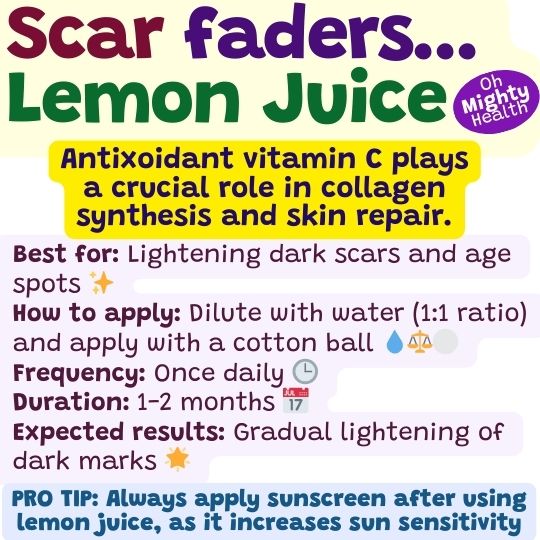
Lemon juice helps treat scars and dark spots because it’s a natural astringent and lightening agent. Its high vitamin C content, a powerful antioxidant, supports collagen production and skin repair.
Lemon juice helps lighten dark scars and age spots by stopping melanin production, which causes skin pigmentation. Its alpha-hydroxy acids (AHAs) gently exfoliate, removing dead skin cells and improving skin texture over time. The juice also has antibacterial properties to prevent infection and reduce scarring. It tightens pores and controls oil, which is good for acne-prone skin. However, its high acidity can make your skin more sensitive to the sun, so always use sun protection when using lemon juice on your skin (here’s a scientific article on how the juice is commonly used with people with acne).
The natural bleaching effect of lemon juice, combined with its exfoliating and antioxidant properties, makes it a powerful, yet gentle option.
- Best for: Lightening dark scars and age spots
- How to apply: Dilute with water (1:1 ratio) and apply with a cotton ball
- Frequency: Once daily
- Duration: 1-2 months
- Expected results: Gradual lightening of dark marks
💡📌 PRO TIP: Always apply sunscreen after using lemon juice, as it increases sun sensitivity
🌼 Calendula – best for wound healing and scar prevention
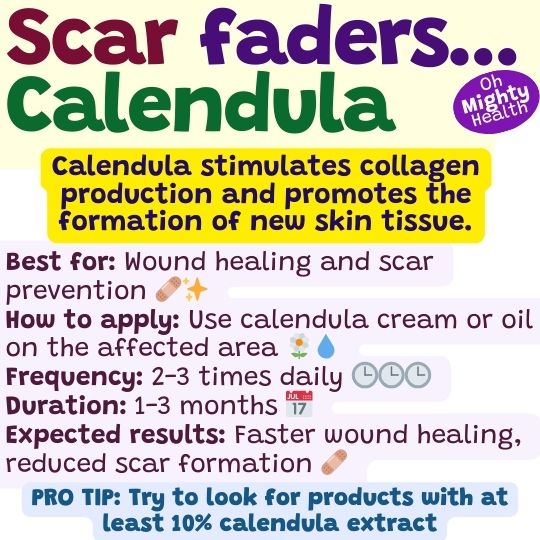
Calendula, derived from marigold flowers, is a potent healing agent for scars and wounds. Its active compounds, including flavonoids and triterpenes, give it strong anti-inflammatory and antimicrobial properties.
Calendula stimulates collagen production and promotes the formation of new skin tissue, crucial for minimising scar formation. It also enhances blood flow to wound sites, accelerating healing. Rich in antioxidants, calendula protects new skin cells from free radical damage. SCIENCE BASED.
Its gentle nature makes it suitable for sensitive skin, helping to soothe irritation while supporting the skin’s natural repair processes.
- Best for: Wound healing and scar prevention
- How to apply: Use calendula cream or oil on the affected area
- Frequency: 2-3 times daily
- Duration: 1-3 months
- Expected results: Faster wound healing, reduced scar formation
💡📌 PRO TIP: Look for products with at least 10% calendula extract
HERE’S A CALENDULA OIL THAT WILL DO THE JOB VERY NICELY.
💜 Lavender oil – best for reducing inflammation and promoting relaxation
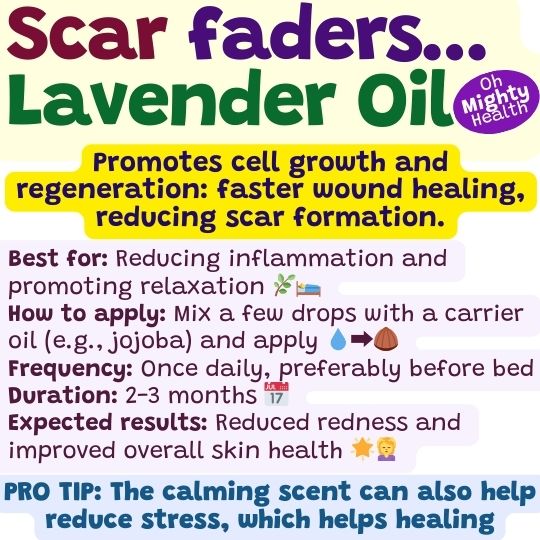
Lavender essential oil is renowned for its skin-healing and stress-reducing properties. Its active compounds, linalool and linalyl acetate, possess potent anti-inflammatory and antiseptic qualities.
These help reduce redness, calm irritation, and prevent infection in healing wounds. Lavender essential oil promotes cell growth and regeneration, aiding in faster wound healing and potentially reducing scar formation. Its ability to balance sebum production makes it beneficial for various skin types. SCIENCE BASED.
The oil’s soothing scent can also reduce stress, indirectly supporting skin health by lowering cortisol levels that can impair healing.
- Best for: Reducing inflammation and promoting relaxation
- How to apply: Mix a few drops with a carrier oil (e.g., jojoba) and apply
- Frequency: Once daily, preferably before bed
- Duration: 2-3 months
- Expected results: Reduced redness and improved overall skin health
💡📌 PRO TIP: The calming scent can also help reduce stress, which aids healing
MY RECOMMENDED LAVENDER ESSENTIAL OIL.
🌟 Frankincense oil – best for fading old scars and improving skin tone
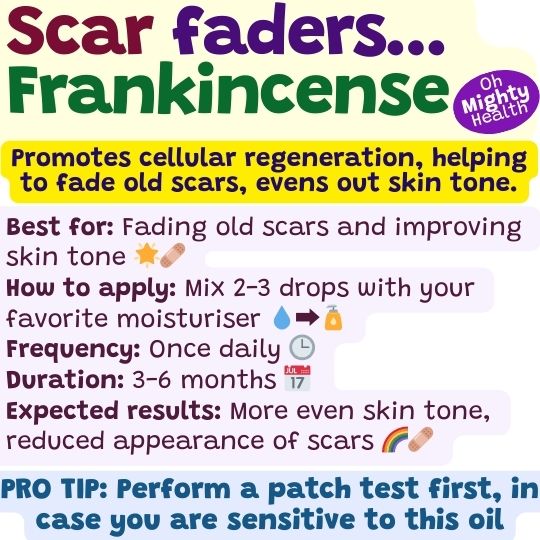
Frankincense essential oil, extracted from Boswellia trees, has been prized for centuries for its skin-rejuvenating properties! Rich in boswellic acids, it possesses powerful anti-inflammatory and antiseptic qualities.
Frankincense essential oil promotes cellular regeneration, helping to fade old scars and even out skin tone. It’s particularly effective in reducing the appearance of stretch marks and age spots. SCIENCE BASED.
The oil tightens skin, which may help reduce new scars. Frankincense also boosts the skin’s natural defence, protecting it from environmental damage that can slow healing.
- Best for: Fading old scars and improving skin tone
- How to apply: Mix 2-3 drops with your favourite moisturiser
- Frequency: Once daily
- Duration: 3-6 months
- Expected results: More even skin tone, reduced appearance of scars
💡📌 PRO TIP: Perform a patch test first, as some people may be sensitive to this potent oil
MY RECOMMENDED FRANKINCENSE ESSENTIAL OIL.
How to get started
Not sure how to get started? Please read the below.
1. First, assess your scar
- Fresh scars (red, raised): Start with aloe vera or calendula
- Old scars: Consider rosehip oil or frankincense
- Hyperpigmentation: Lemon juice or vitamin E oil
- Acne scars: Coconut oil or rosehip oil
- Surgical scars: Vitamin E oil or shea butter
2. Patch test
Always conduct a 24-hour patch test before applying any new ingredient to your scar.
3. Combining ingredients
You can boost efficacy by putting together complementary ingredients:
- Morning: Diluted lemon juice + rosehip oil
- Evening: Lavender oil + shea butter
- Weekly: Gentle massage with cocoa butter, followed by aloe vera gel
4. Application tips
- Cleanse the area before applying treatments
- Use gentle, circular motions when massaging oils or butters
- For essential oils, always dilute with a carrier oil (e.g., jojoba or sweet almond)
5. Be consistent and patient
- Set a daily routine and stick to it
- Take progress photos every two weeks
- Expect visible improvements in 4-12 weeks, depending on the scar
6. Lifestyle factors
- Stay hydrated
- Eat a balanced diet rich in vitamins C, E, and zinc
- Protect your skin from sun exposure
7. When to Seek Professional Help
Consult a dermatologist if:
- Your scar is the result of a deep wound
- You notice any unusual changes in the scar
- You don’t see improvement after 3 months of consistent treatment
Remember, everyone’s skin is unique. Don’t hesitate to adjust your routine based on how your skin responds.
With patience and persistence, these natural remedies can help you achieve smoother, more even-toned skin.
Conclusion
These natural scar faders offer effective alternatives to synthetic products. For optimal results:
- Choose ingredients based on your specific scar type and skin needs
- Combine treatments for synergistic effects (e.g., rosehip oil with vitamin E)
- Apply sunscreen daily to prevent further discolouration
- Consider dietary support with collagen-boosting foods
- Document your progress with photos for motivation
While results vary, many find these remedies gentler on skin and wallet!
Consult a dermatologist for persistent or severe scarring.
Natural scar treatment is a journey. Armed with these tools, you’re well-equipped to nurture your skin back to health.

